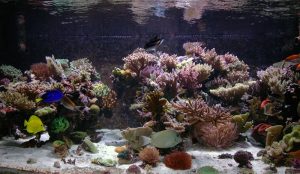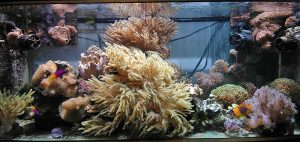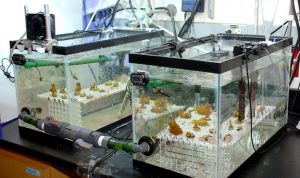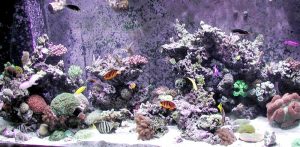Editor’s Note: This article continues from last month’s Advanced Aquarist.
Figure 8. Invertebrate population in the author’s tank during the “week in the life” study.
A survey of TOC levels in marine aquaria run under different husbandry conditions
Water samples from 6 different marine aquaria spanning a range of husbandry conditions were examined for TOC levels. For standardization of the experimental protocol, samples were taken at approximately (a) 0.5 – 2 hours after feeding, (b) 10-12 hours after feeding, and (c) 20-24 hours after feeding. Key tank parameters, aquarium characteristics and husbandry techniques are detailed along with the measured TOC values. All tanks appeared in general to be healthy with thriving livestock and stable conditions.
1. 500 gallon reef tank
- System volume: 550 gallons
- Salt mix: Instant Ocean
- Refugium: No
- Routine additives: none
- Sand bed: 0.5 – 2 inches
- Skimmer: DIY downdraft
- GAC: 2 cups
- Water change: 10% biweekly
- Ca reactor: DIY
- Livestock: fish (> 30) , hard corals, soft corals, snails, starfish, cucumbers, shrimp, live rock
- Feeding Schedule: 2 tsp frozen meaty food, 2/day
| entry | time since last feeding, hours | measured TOC, ppm |
|---|---|---|
| 1 | 0.5 | 0.94 ± 0.07 |
| 2 | 1 | 1.31 ± 0.09 |
| 3 | 1.5 | 1.24 ± 0.05 |
| 4 | 10 | 1.41 ± 0.10 |
| 5 | 14.25 | 1.13 ± 0.02 |
| 6 | 20 | 1.46 ± 0.09 |
| 7 | 24 | 1.10 ± 0.20 |
2. 55-gallon reef tank
- System volume: 55 gallons
- Salt mix: Instant Ocean
- Refugium: No
- Routine additives: none
- Sand bed: no
- Skimmer: no
- GAC: 1 cup
- Water change: rarely
- Ca reactor: no
- Livestock: fish (7, ~ 16 inches in total), soft corals, starfish, live rock
- Feeding Schedule: 0.75 tsp frozen meaty food, 1/day
| entry | time since last feeding, hours | measured TOC, ppm |
|---|---|---|
| 1 | 1 | 0.71 ± 0.04 |
| 2 | 10 | 0.69 ± 0.05 |
| 3 | 20 | 0.59 ± 0.05 |
3. 29-gallon reef tank
- System volume: 29 gallons
- Salt mix: Instant Ocean
- Refugium: No
- Routine additives: none
- Sand bed: no
- Skimmer: no
- GAC: no
- Water change: rarely
- Ca reactor: no
- Livestock: fish (4, ~ 9 inches in total), soft corals, starfish, shrimp, live rock
- Feeding Schedule: 0.5 tsp frozen meaty food, 1/day
- Inorganic nutrient levels: [NH4] < 0.25 ppm (test limit), [NO3] 50 ppm, [NO2] = 2 ppm, [Ca] = 405 ppm, [Mg] = 1365 ppm, [alk] = 2.40 meq/L (Salifert); [PO4] > 0.43 ppm (Merck test limit)
| entry | time since last feeding, hours | measured TOC, ppm |
|---|---|---|
| 1 | 1.5 | 5.5 ± 0.2 |
| 2 | 10 | 5.4 ± 0.5 |
| 3 | 20 | 5.9 ± 0.3 |
4. 30-gallon coral frag propagation system
- System volume: 30 gallons
- Salt mix: Instant Ocean
- Refugium: No
- Routine additives: none
- Sand bed: no
- Skimmer: Aqua C Remora
- GAC: yes
- Water change: 17%/week
- Ca reactor: no
- Livestock: hard corals, shrimp, snails
- Feeding Schedule: 0.5 tsp Phytofeast, 0.5 tsp Rotifeast, 1/day
| entry | time since last feeding, hours | measured TOC, ppm |
|---|---|---|
| 1 | 1 | 1.63 ± 0.03 |
| 2 | 9 | 1.44 ± 0.06 |
| 3 | 24 | 1.20 ± 0.03 |
5. 250-gallon reef tank
- System volume: 370 gallons
- Salt mix: Instant Ocean
- Refugium: Yes
- Routine additives: none
- Sand bed: 2 inches
- Skimmer: Aquamedic
- GAC: yes
- Water change: 10%/2 weeks
- Ca reactor: Yes
- Livestock: fish (22, ~ 75″), hard corals, soft corals, live rock, crabs, snails, cukes, starfish
- Feeding Schedule: 1 tsp meaty food, 1 tsp flakes, 1/16 tsp pellets, 4 sq inches nori @ 2 or 3 times/day
| entry | time since last feeding, hours | measured TOC, ppm |
|---|---|---|
| 1 | 1 | 0.65 ± 0.01 |
| 2 | 11 | 0.62 ± 0.3 |
| 3 | 24 | 0.63 ± 0.02 |
6. 500-gallon reef tank
- System volume: 600 gallons
- Salt mix: Instant Ocean
- Refugium: Yes
- Routine additives: Ca, Mg
- Sand bed: 2 inches
- Skimmer: ETSS 1200
- GAC: yes
- Water change: 7%/week
- Ca reactor: Yes
- Livestock: fish (~ 60, ~ 140 inches), hard corals, soft corals, live rock, crabs, snails, cukes, starfish
- Feeding Schedule: 3 tsp meaty food, 2 tsp flakes, 1 tsp pellets, 4 sq inches nori @ 1 time/day
| entry | time since last feeding, hours | measured TOC, ppm |
|---|---|---|
| 1 | 1 | 1.10 ± 0.01 |
| 2 | 11 | 1.01 ± 0.02 |
| 3 | 24 | 0.97 ± 0.01 |
Four of the seven aquaria examined in this study (the author’s tank and tanks # 1, 5, and 6) are reef tanks that fit the standard Berlin model: sand, rocks, a protein skimmer, and GAC (Granular Activated Carbon). All of these tanks have diverse livestock including fish, corals, snails, and assorted other invertebrates. Interestingly, all of the “standard model” tanks exhibited TOC values that mapped closely onto the range observed for healthy, thriving natural reefs; 0.7 – 1.4 ppm. The three remaining successful aquaria do not contain one or more of the “standard model” components, and the TOC values of these atypical tanks are on the outside edges, or deviate entirely, from natural reef values. For example, tank #4 lacks sand and rock, but does have a skimmer and uses GAC. No fish are in residence, as the livestock consists of only hard coral frags and a few snails and shrimp. Thus, the presumed major repositories of bacteria (sand and rocks) are missing, and there is only minimal coral volume to house bacteria. For this tank, the TOC values (~ 1.2 – 1.6 ppm) are at the upper edge or exceed those found on natural reefs. Nevertheless, the coral frags apparently have adapted and are thriving. Tank #2 lacks sand and a skimmer, but it does contain generous amounts of live rock, a few fish, and several large, mature colonies of soft corals; significantly, GAC is used continuously. The TOC values found in this tank (~ 0.7 ppm) are at the lower edge of the range found on natural reefs. Finally, tank 3 is the most primitive of all; no water purification equipment (skimmer or GAC) is employed, some live rock is incorporated, and no sandbed is present. Nevertheless, the fish and soft corals are thriving. The TOC levels in this aquarium are exceptionally high (> 5 ppm), as are the nitrate and phosphate concentrations. Presumably, the absence of purification equipment is reflected in the high TOC and nitrate/phosphate levels; all the same, the livestock seems to have adapted. The somewhat subversive thesis that perhaps skimmers do not contribute much to TOC removal/water purification was raised in the discussion of Figs. 5 and 6; the exceedingly low TOC values in the skimmerless tank #2 provide further support for this notion. What then, distinguishes this tank from the other skimmerless tank, #3, which has exceedingly high TOC levels? Both tanks lack sandbeds and have similar fish loads and soft coral/invertebrate populations. The one identifiable difference in husbandry between them involves GAC; the low TOC tank (#2) uses GAC-based water filtration, whereas the high-TOC tank (#3) does not. Does GAC really make such a spectacular difference in TOC loads while at the same time protein skimmers scarcely have any effect at all? This question and related topics are currently under study, and results will be reported in the near future.
Conclusions
Coral reefs have been characterized as oases of biological productivity in a marine desert (Capone, 1992). The surrounding oligotrophic (= nutrient depleted) waters provide little sustenance to the reef biota. As a consequence, complex nutrient recycling webs have evolved on reefs to retain and reutilize essential elements like nitrogen and carbon. The carbon cycle on reefs is multifaceted and is beginning to be unraveled. Reliable measurements of dissolved organic carbon (DOC) levels are critical for this goal, and the introduction of the Shimadzu TOC Analyzer represents an unequivocal leap forward in research capability. On thriving reefs, most carbon input originates with atmospheric CO2, which is “fixed” via photosynthesis first into carbohydrates, and then into a multitude of other organic molecules. Much of this carbon, which is generated by the zooxanthellae in corals, is reemitted as coral mucus. This coral contribution significantly enriches the pool of DOC.
This DOC is prime food for a large variety of reef microbiota, including bacteria, both in the water column and in the corals themselves, and microplankton, etc. Finally, these microflora and microfauna serve as food for a variety of filter feeders, including, again, the corals. Thus, the interdependency of reef organisms, both large and small, is revealed as the carbon-based nutrients are recycled. The surrounding oligotrophic ocean serves as a buffer which can absorb excess nutrients that might otherwise prove harmful to reef inhabitants and modulate the levels of dissolved species by import and export, depending on relative (reef vs. open ocean) concentrations. Our captive reefs fall far short of this nutrient commerce model; we have, of course, no open ocean buffer to dilute away waste and so we rely on water changes to perform this vital function, and it remains unclear whether our aquaria contain all of the components, in appropriate proportions, of authentic reefs necessary to promote efficient nutrient recycling. Nevertheless, what we do seems to work, at least most of the time. But, what happens when things go wrong? Circumstantial evidence from Rohwer’s studies implicates DOC imbalances in coral mortality, with runaway bacterial growth as a likely mediating culprit. Can these observations inform aquarists, and is there a response that might ameliorate the problem? Certainly the first step is to establish a baseline of TOC ( DOC) levels in healthy reef aquaria under different husbandry protocols. In this article, data has been presented that accomplishes this goal, and further, validates these TOC numbers by comparison to TOC/DOC levels on healthy reefs around the world. In addition, the surprisingly minimal impact of protein skimming on TOC levels was revealed. On this point, it is apparent that if TOC levels can be monitored to assay the effects of one skimmer (the H&S A200 in this case), then they can be monitored to measure the impact of different types of skimmers operating on an experimental tank. In addition, these types of experiments also can be used to probe more directly and quantitatively the TOC removal capabilities of Granular Activated Carbon (GAC) that was hinted at in the tank #2 vs. tank #3 comparison. These types of experiments might allow, for the first time, a quantitative evaluation of skimmer and, independently, GAC performance which is divorced from the hype and misinformation that seems to surround these areas of marine aquarium maintenance/equipment. These experiments are ongoing and results will be reported in due course.
Finally, the goal of identifying approaches to halt incidents of coral mortality in reef tanks may benefit from data collection from “sick” tanks rather than the healthy aquaria examined in this study. If tanks undergoing coral crashes have an unusually high (or low) amount of TOC in the water but otherwise have acceptable water parameters, then a new and otherwise unappreciated villain will be in hand. Under these circumstances, what can the aquarist do? One experiment described by Ferrier-Pagès on Galaxea provides food for thought. Specimens of this coral were treated with the combined antibiotics penicillin, streptomycin, and amphotericin; subsequent bacterial uptake of DOC, which Rohwer identified as a mechanism for coral mortality when occurring in excess, ceased.
Acknowledgment
We thank the Eberly College of Science at the Pennsylvania State University for financial support, Dr. Bruce Logan and Mr. David Jones of the Pennsylvania State University Department of Civil and Environmental Engineering for use of the Shimadzu 5000 TOC Analyzer, and members of SCARS (State College Aquarium and Reef Society) for donating water samples.
References
- Ainsworth, T. D.; Fine, M.; Roff, G.; Hoegh-Guldberg, O. 2008. “Bacteria are not the Primary Cause of Bleaching in the Mediterranean Coral Oculina patagonica.” Int. Soc. Microbial Ecol. Journal, 2, 67-73.
- Allers, E. 2007a. Ph.D. Thesis: “Response of Marine Bacterioplankton to Experimental Manipulations of Growth Conditions.” Fachbereich Biologie/Chemie der Universität Bremen.
- Allers, E.; Gómez-Consarnau, L.; Pinhassi, J.; Gasol, J. M.; Simek, K.; Pernthaler, J. 2007b. “Response of Alteromonadaceae and Rhodobacteriaceae to Glucose and Phosphorus Manipulation in Marine Mesocosms.” Environ. Microbiol., 9, 2417- 2429.
- Baker, A. C. 2003. “Flexibility and Specificity in Coral-Algal Symbiosis: Diversity, Ecology, and Biogeography of Symbiodinium.” Annu. Rev. Ecol. Evol. Syst. 34, 661-689.
- Benner, R. 2002. in Biogeochemistry of Marine Dissolved Organic Matter, Academic Press, San Diego, USA.
- Bourne, D. G.; Munn, C. B. 2005. “Diversity of Bacteria Associated with the Coral Pocillipora damicornis from the Great Barrier Reef.” Environ. Microbiol., 7, 1162-1174.
- Capone, D. G.; Dunham, S. E.; Horrigan, S. G.; Duguay, L. E. 1992. “Microbial Nitrogen Transformations in Unconsolidated Coral Reef Sediments.” Mar. Ecol. Prog. Ser., 80, 1992.
- Costanza, R.; D’Arge, R.; de Groot, R.; Farber, S.; Grasso, M.; Hannon, B.; Limburg, K.; Naeem, S.; O’Neil, R. V.; Paruelo, J.; Raskin, R. G.; Sutton, P.; van den Belt, M. 1997. “The Value of the World’s Ecosystem Services and Natural Capital.” Nature, 387, 253-260.
- Covert, J. S.; Moran, M. A. 2001. “Molecular Characterization of Estuarine Bacterial Communities that Use High- and Low-Molecular Weight Fractions of Dissolved Organic Carbon.” Aquat. Microb. Ecol., 25, 127-139.
- Crossland, C. J.; Barnes, D. J.; Borowitzka, M. A. 1980. “Diurnal Lipid and Mucus Production in the Staghorn Coral Acropora acuminata.” Mar. Biol., 60, 81-90.
- Crossland, C. J. 1987. “In Situ Release of Mucus and DOC-Lipid from the Corals Acropora variabilis and Stylopora pistillata.” Coral Reefs, 6, 35-42.
- Ducklow, H. W.; Mitchell, R. 1979. “Bacterial Populations and Adaptations in the Mucus Layers on Living Corals.” Limnol. Oceanogr., 24, 715-725.
- Ducklow, H. W. 1983. “Production and Fate of Bacteria in the Oceans.” BioScience, 33, 494-501.
- Ducklow, H. W. 2002. in Biogeochemistry of Marine Dissolved Organic Matter, Academic Press, San Diego, USA.
- Eppley, R. W. 1980. “Estimating Phytoplankton Growth Rates in the Central Oligotrophic Oceans.” Brookhaven Symp. Biol., 31, 231-242.
- Feldman, K. S. 2006. “My Dialyseas Saga: Pros and Cons.” Reefkeeping, issue 2006-4.
- Ferrier-Pagès, C.; Gattuso, J.-P.; Cauwet, G.; Jaubert, J.; Allemand, D. 1998. “”Release of Dissolved Organic Carbon and Nitrogen by the Zooxanthellate Coral Galaxea fascicularis.” Mar. Ecol. Prog. Ser., 172, 265-274.
- Ferrier-Pagès, C.; Leclercq, N.; Jaubert, J.; Pelegri, S. P. 2000. “Enhancement of Pico- and nanoplankton Growth by Coral Exudates.” Aquat. Microb. Ecol., 21, 203-209.
- Fu, W.; Wu, Y.; Sun, L.; Zhang, W. 2007. “Efficient Bioremediation of Total Organic Carbon (TOC) in Intergrated Aquaculture System by Marine Sponge Hymeniacidon perleve.” Biotech. Bioeng., 97, 1387-1397.
- Gardner, T. A.; Cote, I. M.; Gill, J. A.; Grant, A.; Watkinson, A. R. 2003. “Long-Term, Region-Wide Declines in Caribbean Corals.” Science, 301, 958-960.
- González, J. M.; Simó, R.; Massana, R.; Covert, J. S.; Casamayor, E. O.; Pedrós-Alió, C.; Moran, M. A. 2000. “Bacterial Community Structure Associated with a Dimethylsulfoniopropionate-Producing North Atlantic Algal Bloom.” Appl. Environ. Microbiol., 66, 4237-4246.
- Gottfried, M.; Roman, M. R. 1983. “Ingestion and Incorporation of Coral Mucus Detritus by Reef Zooplankton.” Mar. Biol., 72, 211-218.
- Grossart, H. P.; Levold, F.; Allgaier, M.; Simon, M.; Brinkhoff, T. 2005. “Marine Diatom Species Harbour Distinct Bacterial Communities.” Environ. Microbiol., 7, 860-873.
- Hata, H.; Kudo, S.; Yamano, H.; Kurano, N.; Kayanne, H. 2002. “Organic Carbon Flux in Shiraho Coral Reef (Ishigaki Island, Japan).” Mar. Ecol. Prog. Ser., 232, 129-140.
- Hedges, J. I. 2002. in Biogeochemistry of Marine Dissolved Organic Matter, Academic Press, San Diego, USA.
- Hesson, D. O.; Anderson, T. R. 2008. “Excess Carbon in Aquatic Organisms and Ecosystems: Physiological, Ecological, and Evolutionary Implications.” Limnol. Oceanogr., 53, 1685-1696.
- Holmes-Farley, R. 2004. “Organic Compounds in the Reef Aquarium.” Reefkeeping, http://www.reefkeeping.com/issues/2004-10/rhf/.
- Johannes, R. E. 1967. “Ecology of Organic Aggregates in the Vicinity of a Coral Reef.” Limnol. Oceanogr., 12, 189-195.
- Kirchman, D. L. 1990. “Limitation of Bacterial Growth by Dissolved Organic Matter in the Subartic Pacific.” Mar. Ecol. Prog. Ser., 62, 47-54.
- Klaus, J. S.; Janse, I.; Heikoop, J. M.; Sanford, R. A.; Fouke, B. W. 2007. “Coral Microbial Communities, Zooxanthellae and Mucus Along Gradients of Seawater Depth and Coastal Pollution.” Environ. Microbiol., 9, 1291-1305.
- Kline, D. I.; Kuntz, N. M.; Breitbart, M.; Knowlton, N.; Rohwer, F. 2006. “Role of Elevated Organic Carbon Levels and Microbial Activity in Coral Mortality. Mar. Ecol. Prog. Ser., 314, 119-125.
- Kooperman, N.; Ben-Dov, E.; Kramarsky-Winter, E.; Barak, Z.; Kushmaro, A. 2007. “Coral Mucus-Associated Bacterial Communities from Natural and Aquarium Environments.” Fed. Eur. Microbiol. Soc., 276, 106-113.
- Kuntz, N. M.; Kline, D. I.; Sandin, S. A.; Rohwer, F. 2005. “”Pathologies and Mortality Rates Caused by Organic Carbon and Nutrient Stressors in Three Caribbean Coral Species.” Mar. Ecol. Prog. Ser., 294, 173-180.
- LaJeunesse, T. C. 2005a. “”Species” Radiations of Symbiotic Dinoflagellates in the Atlantic and Indo-Pacific since the Miocene-Pliocene Transition.” Mol. Bio. Evol., 22, 570-581.
- LaJeunesse, T. C.; Thornhill, D. J.; Cox, E. F.; Stanton, F. G.; Fitt, W. K.; Schmidt, G. W. 2005b. “High Diversity and Host Specificity Observed among Symbiotic Dinoflagellates in Reef Coral Communities from Hawaii.” Coral Reefs, 23, 596-603.
- Lampert, Y.; Kelman, D.; Dubinsky, Z.; Nitzan, Y.; Hill, R. T. 2006. “”Diversity of Culturable Bacteria in the Mucus of the Red Sea Coral Fungia scutaria.” FEMS Microbiol. Ecol., 58, 99-108.
- Liess, A. 2006. Ph.D. Thesis: “Nutrient Stoichiometry in Benthic Food Webs – Interactions between Algae, Herbivores and Fish.” Faculty of Science and Technology, Uppsala Universitet.
- Means, J. C.; Sigleo, A. C. 1986. “Contribution of Coral Reef Mucus to the Colloidal Pool in the Vicinity of Discovery Bay, Jamaica.” W. I. Bull. Mar. Sci., 39, 110-118.
- Meikle, P.; Richards, G. N.; Yellowlees, D. 1988. “Structural Investigations of the Mucus from Six Species of Coral.” Mar. Biol., 99, 187-193.
- Moriarty, D. J. W.; Pollard, P. C.; Hunt, W. G. 1985. “Temporal and Spatial Variation in Bacterial Production in the Water Column over a Coral Reef.” Mar. Biol., 85, 285-292.
- Ogawa, H.; Ogura, N. 1992. “Comparison of Two Methods for Measuring Dissolved Organic Carbon in Sea Water.” Nature, 356, 696-698.
- Pagès, J.; Torréton, J.-P.; Sempéré, R. 1997. “Dissolved Organic Carbon in Coral-Reef lagoons, by High Temperature Catalytic Oxidation and UV Spectroscopy.” C.R. Acad. Sci. Paris, série IIa, 324, 915-922.
- Pinhassi, J.; Sala, M. M.; Havskum, H.; Peters, F.; Guadayol, O.; Malits, A.; Marrase, C. 2004. “Changes in Bacterioplankton Composition under Different Phytoplankton Regimens.” Appl. Environ. Microbiol., 70, 6753-6766.
- Rich, J. H.; Ducklow, H. W.; Kirchman, D. L. 1996. “Concentrations and Uptake of Neutral Monosaccharides along 140oW in the Equatorial Pacific: Contribution of Glucose to Heterotrophic Bacterial Activity and the DOM Flux.” Limnol. Oceanogr., 41, 595-604.
- Ritchie, A.; Lewis, T. D. 2008. “Bacterial Composition of Surface Associated Microbes Found in Three Hawaiian Coral Species: Porities compressa, Porities lobata, and Montipora capitata.” J. Young Invest., 18, issue 6.
- Rohwer, F.; Breitbart, M.; Jara, J.; Azam, F.; Knowlton, N. 2001. “Diversity of Bacteria Associated with the Caribbean Coral Montastraea franksi.” Coral Reefs, 20, 85-95.
- Rohwer, F.; Seguritan, V.; Azam, F.; Knowlton, N. 2002. “Diversity and Distribution of Coral-Associated Bacteria.” Mar. Ecol. Prog. Ser., 243, 1-10.
- Rosenberg, E.; Koren, O.; Reshef, L.; Efrony, R.; Zilber-Rosenberg, I. 2007a. “”The Role of Microorganisms in Coral Health, Disease, and Evolution.” Nature Reviews: Microbiol. 5, 355-362.
- Rosenberg, E.; Kellogg, C. A.; Rohwer, F. 2007b. “Coral Microbiology.” Oceanography, 20, 146-154.
- Sharon, G.; Rosenberg, E. 2008. “Bacterial Growth on Coral Mucus.” Curr. Microbiol., 56, 481-488.
- Sharp, J. H.; Benner, R.; Bennett, L.; Carlson, C. A.; Dow, R.; Fitzwater, S. E. 1993. “Re-evaluation of High Temperature Combustion and Chemical Oxidation Measurements of Dissolved Organic Carbon in Seawater.” Limnol. Oceanogr. 38, 1774-1782.
- Sharp, J. H.; Benner, R.; Bennett, L.; Carlson, C. A.; Fitzwater, S. E.; Peltzer, E. T.; Tupas, L. M. 1995. “Analyses of Dissolved Organic Carbon in Seawater: the JGOFS EqPac Methods Comparison.” Mar. Chem. 48, 91-108.
- Sharp, J. H. 2002. in Biogeochemistry of Marine Dissolved Organic Matter, Academic Press, San Diego, USA.
- Sorokin, Y. I. (Ed.). 1993. Coral Reef Ecology. Springer-Verlag, Berlin.
- Sterner, R. W.; Elser, J. J. 2002. Ecological Stoichiometry: The Biology of Elements from Molecules to the Biosphere. Princeton Press, New Jersey.
- Torréton, J.-P. 1999. “Biomass, Production and Heterotrophic Activity of Bacterioplankton in the Great Astrolabe Reef Lagoon (Fiji).” Coral Reefs, 18, 43-53.
- van Duyl, F. C.; Gast, G.|J. 2001 “Linkage of Small-Scale Spatial Variations in DOC, Inorganic Nutrients and Bacterioplankton Growth with Different Coral Reef Water Types.” Aquatic Microbiol. Ecol., 24, 17-26.
- Weiss, M.; Simon, M. 1999. “”Consumption of Labile Dissolved Organic Matter by Limnetic Bacterioplankton: the Relative Significance of Amino Acids and Carbohydrates.” Aquat. Microb. Ecol., 17, 1-12.
- Wild, C.; Huettel, M.; Klueter, A.; Kremb, S. G.; Rasheed, M. Y. M.; Jergensen, B. B. 2004. “Coral Mucus Functions as an Energy Carrier and Particle Trap in the Reef Ecosystem.” Nature, 428, 66-70.
- Yahel, G.; Sharp, J. H.; Dominique, M.; Häse, C.; Genin, A. 2003. “In Situ Feeding and Element Removal in the Symbiont-Bearing Sponge Theonella swinhoei: Bulk DOC is the Major Source for Carbon.” Limnol. Oceanogr. 48, 141-149.
- Yoshinaga, I.; Fukami, K.; Ishida, Y. 1991. “Comparison of DNA and Protein Synthesis Rates of Bacterial Assemblages between Coral Reef Waters and Pelagic Waters in Tropical Ocean.” Mar. Ecol. Prog. Ser., 76, 167-174.



















0 Comments